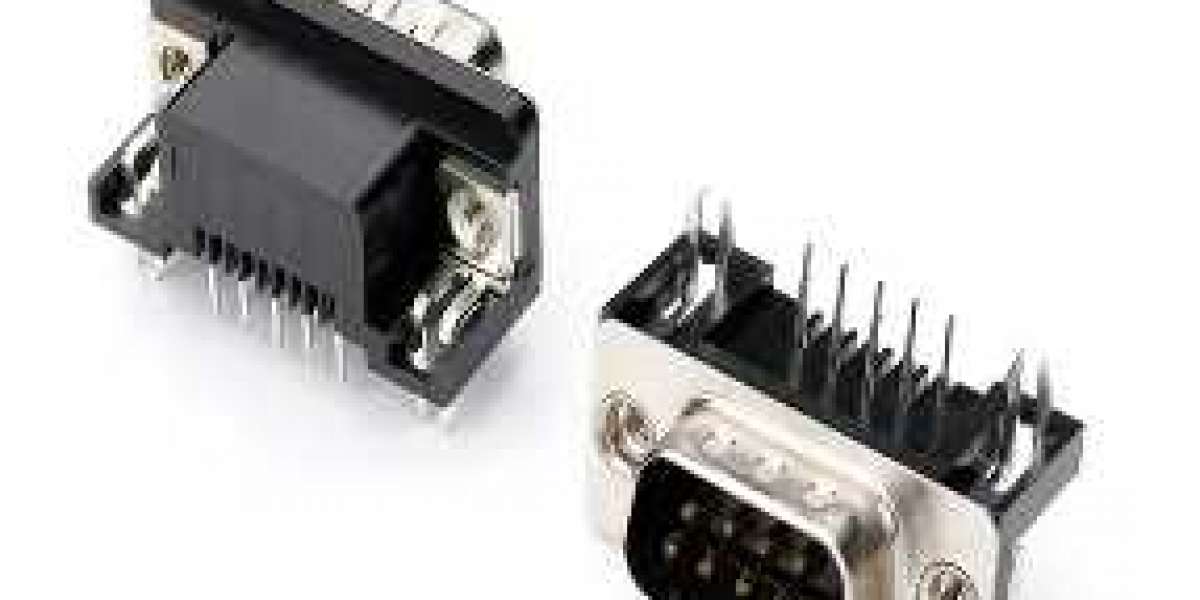D-Sub standard connectors are crucial components in electronic devices, facilitating data transmission and power supply. Understanding the significance of these connectors is essential for anyone dealing with electronics or technology. These connectors come in various sizes and pin configurations to suit different applications, ensuring compatibility and efficient performance. Whether you are a tech enthusiast or a professional in the field, grasping the basics of D-Sub standard connectors can enhance your knowledge and skills.
For those delving into electronics or seeking to broaden their understanding of technology, exploring the world of D-Sub standard connectors opens up a realm of possibilities. Stay tuned as we delve deeper into the functionalities, types, and applications of these vital components in upcoming posts.
Purpose and Function of D-Sub Connectors
Data Transmission
D-Sub standard connectors play a crucial role in facilitating data transmission among electronic devices. These connectors are commonly found in computers, printers, and other electronic equipment. They ensure that information can flow smoothly between devices without interference or loss.
D-Sub connectors are designed to carry both analog and digital signals efficiently. For instance, they can transmit video signals from a computer to a monitor with high clarity and minimal distortion. This makes them versatile components for various applications where data transfer is essential.
Secure Connection
One key advantage of D-Sub standard connectors is their ability to establish secure connections between devices. The design of these connectors includes multiple pins that fit snugly into corresponding sockets, creating a stable link. This ensures that the connection remains intact even when subjected to movement or vibrations.
Moreover, the sturdy construction of D-Sub connectors enhances their durability, making them suitable for long-term use without frequent replacements. Their robust build provides users with confidence in the reliability of their connections, especially in critical systems where uninterrupted data transmission is paramount.
Types of D-Sub Connectors
Standard Connectors
D-Sub standard connectors are one of the most common types, known for their versatility and wide usage in various applications. These connectors come in different sizes, with DB9 and DB25 being the most prevalent options. A DB9 connector has 9 pins, while a DB25 connector features 25 pins. The number of pins determines the capabilities and functions these connectors can support.
Standard D-Sub connectors are typically used for basic applications that require a moderate number of connections. They are suitable for devices like computer monitors, printers, and industrial equipment where a limited number of signals need to be transmitted between components efficiently.
High-Density Connectors
In contrast to standard D-Sub connectors, high-density variants pack more pins into a smaller space. These connectors offer increased pin density per inch compared to their standard counterparts, allowing for more connections within the same form factor. High-density D-Sub connectors are commonly found in applications that demand a higher pin count within limited space constraints.
High-density D-Sub connectors excel in scenarios where multiple signals or data streams need to be transmitted simultaneously through a single connection point efficiently. Industries such as telecommunications, aerospace, and automotive often utilize high-density versions for their compact yet robust design.
Specialized Variants
Apart from standard and high-density configurations, there exist specialized variants of D-Sub connectors tailored for specific purposes or environments. These specialized versions may feature unique designs such as waterproof seals or rugged casings to withstand harsh conditions like moisture exposure or extreme temperatures.
Specialized D-Sub connectors cater to niche industries requiring custom solutions beyond what standard or high-density models can offer. For instance, military-grade equipment often utilizes specialized D-Sub connectors designed to meet stringent durability and performance requirements.
Advantages of Using D-Sub Connectors
Excellent EMI/RFI Shielding
D-Sub standard connectors are known for their excellent EMI/RFI shielding properties, which help in maintaining signal integrity. This shielding capability prevents electromagnetic interference (EMI) and radio-frequency interference (RFI) from disrupting the signals passing through the connectors. By using D-Sub connectors, you can ensure that your data transmissions remain stable and free from external disturbances.
D-Sub connectors achieve this high level of shielding effectiveness through their design, which includes metal shells surrounding each connection point. These metal shells act as barriers against unwanted electromagnetic radiation, thereby protecting the signals being transmitted within the connector. For applications where signal quality is crucial and susceptibility to interference is a concern, D-Sub connectors stand out as a reliable choice.
Durability in Harsh Environments
One key advantage of utilizing D-Sub standard connectors is their durability even in harsh environmental conditions. Whether exposed to extreme temperatures, moisture, or mechanical stress, these connectors are built to withstand tough situations without compromising performance. Their robust construction ensures that they can maintain connectivity and functionality over extended periods.
In industrial settings or outdoor installations where equipment may be subjected to rugged conditions, relying on D-Sub connectors offers peace of mind regarding consistent operation. The resilience of these connectors makes them suitable for various applications across different industries where reliability is paramount.
Cost-Effectiveness
When considering connectivity solutions for electronic devices or systems, cost-effectiveness plays a significant role in decision-making. D-Sub standard connectors emerge as an economical option compared to other alternatives available in the market. Despite offering superior shielding capabilities and durability features, these connectors come at a reasonable price point.
The affordability of D-Sub connectors makes them accessible for both small-scale projects and large-scale deployments where multiple connections are required. By choosing cost-effective components like D-Sub standard connectors without compromising on quality or performance, businesses can effectively manage their expenses while ensuring reliable connectivity solutions.
Standard and High-Density D-Sub Connectors
Pin Spacing
Standard D-Sub connectors are ideal for general purposes due to their larger pin spacing. This feature allows them to accommodate a wide range of applications, from data transmission to industrial machinery control. On the other hand, high-density D-Sub connectors have smaller pin spacing, enabling more pins in the same-sized connector. This characteristic makes high-density connectors suitable for scenarios where space is limited, such as in compact electronic devices like laptops or tablets.
The difference in pin spacing between standard and high-density D-Sub connectors directly impacts their versatility and application suitability. While standard D-Sub connectors provide ample space between pins for various uses, high-density versions maximize pin count within a confined area. For instance, if you need to connect multiple components in a limited space without compromising performance or reliability, opting for a high-density D-Sub connector would be advantageous.
Common Applications
When choosing between standard and high-density D-Sub connectors, considering the available space and the number of connections required is crucial. Standard variants offer ease of use with their wider pin spacing but may not be suitable for compact devices that demand multiple connections within a small area. In contrast, high-density connectors excel in situations where maximizing connectivity within limited space is essential.
To illustrate further, imagine designing a medical device that requires numerous sensors and actuators to operate efficiently while maintaining portability. In this scenario, utilizing high-density D-Sub connectors would enable you to incorporate all necessary connections without compromising the device's size or functionality.
Specialized D-Sub Connectors
Filtered Variants
Filtered D-Sub connectors are crucial in minimizing electromagnetic interference. They are ideal for applications where reducing signal noise is essential. These connectors feature components that help mitigate unwanted signals, ensuring optimal performance in sensitive environments.
These connectors come equipped with filters to block out electromagnetic interference effectively. By using filtered D-Sub connectors, industries such as aerospace, telecommunications, and medical equipment manufacturing can maintain signal integrity without disruptions.
Waterproof and High-Voltage Designs
Waterproof D-sub connectors are specifically crafted to endure exposure to moisture and liquids. Industries like marine, outdoor electronics, and automotive rely on these robust connectors for reliable connections even in challenging environments.
In contrast, high-voltage variants of D-Sub connectors cater to applications requiring power transmission at elevated voltages. Designed with safety features and insulation properties, these specialized connectors ensure secure connections for high-power devices like industrial machinery or electrical equipment.
Applications of D-Sub Connectors
Computer Systems
D-sub standard connectors are widely used in computers for various purposes. They can be found in serial ports, parallel ports, and VGA connections. These connectors play a crucial role in ensuring smooth data transfer between different computer components.
D-sub connectors provide reliable solutions for connecting peripherals such as printers, scanners, and external monitors to computers. Their versatility makes them essential components in computer systems where multiple devices need to communicate effectively.
Industrial Automation and Telecommunications
In industrial automation equipment, D-sub connectors facilitate the connection of sensors, actuators, and control systems. Their robust design ensures stable connections even in harsh industrial environments with high levels of vibration or electromagnetic interference.
Telecommunications devices also benefit from the use of D-sub connectors for secure data transmission. These connectors enable seamless connectivity between networking equipment like routers, switches, and modems.
Aerospace and Military Industries
The aerospace and military industries rely on D-sub connectors due to their ruggedness and reliability. In aerospace applications, these connectors are used in avionics systems for communication interfaces that require consistent performance under extreme conditions.
For military applications, D-sub standard connectors are preferred for their durability in harsh environments such as combat zones or field operations. They provide secure connections vital for critical communication systems used by military personnel.
Installation Techniques for D-Sub Connectors
Proper Alignment
When installing D-Sub standard connectors, it is crucial to align the connector accurately with the mating port. This ensures a smooth insertion process without damaging any pins. By aligning the connector properly, you reduce the risk of misalignment and potential harm to the device.
It's essential to take your time during this step to avoid any issues later on. Misaligned connectors can lead to poor connections or even damage components within the device. Always double-check that both ends are correctly aligned before proceeding with insertion.
Applying Even Pressure
To prevent bending pins when inserting D-Sub connectors, apply even pressure throughout the process. Uneven force can cause pins to bend or break, affecting the overall connection quality. By exerting consistent pressure, you ensure a secure fit without compromising any internal components.
Remember that these connectors are delicate, so handling them with care is paramount. Avoid forcing the connector into place and instead use gentle but firm pressure until it slots in smoothly. This approach minimizes the risk of damage and guarantees a reliable connection between devices.
Securing Locking Screws
After inserting the D-Sub connector, use a screwdriver or appropriate tool to secure its locking screws firmly in place. These screws play a vital role in maintaining a stable connection by preventing accidental disconnection due to vibrations or movement. Tightening them adequately ensures a secure link between devices.
Securing locking screws also adds an extra layer of protection against external factors that could loosen or disconnect the connector over time. It's advisable to check these screws periodically for any signs of loosening and retighten them as needed for uninterrupted connectivity.
D-Sub Connector Sizes and Variations
Various Sizes of D-Sub Connectors
D-Sub standard connectors are available in a range of sizes, with the most common ones being DB9, DB15, DB25, and DB37. These sizes correspond to the number of pins each connector holds, starting from 9 pins for DB9 up to 37 pins for DB37. The size of the connector is crucial as it determines how many wires or signals can be transmitted through it.
When choosing a D-Sub connector, consider the number of pins needed based on your specific application requirements. For instance, if you only need to transmit a few signals or data points, a smaller-sized DB9 connector might suffice. On the other hand, applications requiring more complex connections may benefit from larger-sized connectors like DB25 or DB37.
High-Density Connectors
In addition to standard sizes like DB9 and DB25, there are high-density variations of D-Sub connectors available. These high-density connectors pack more pins into the same-size shell compared to their standard counterparts. For example, while a traditional DB25 connector has 25 pins arranged in two rows within its shell, a high-density version could accommodate more than 25 pins by utilizing smaller pin spacing.
High-density D-Sub connectors offer increased pin count capabilities without sacrificing space efficiency. They are commonly used in applications where space is limited but multiple connections need to be made simultaneously. Industries such as aerospace and telecommunications often rely on these high-density variants for their compact yet versatile design.
Pros and Cons
Pros:
Versatile options catering to different pin count requirements.
High-density variants maximize pin count in limited space.
Cons:
More significant pin counts can lead to higher complexity during installation.
Future of D-Sub Connectors
Widely Used Despite Technological Advancements
D-Sub standard connectors remain prevalent in various industries due to their reliability. Despite technological advancements, the durability and robustness of D-Sub connectors make them a popular choice for many applications. They are trusted for their ability to provide secure connections in harsh environments where other connector types might fail.
D-Sub connectors are commonly used for various applications such as data transmission, video output, and power supply. Their versatility and sturdiness have made them a staple in industries like telecommunications, industrial automation, and instrumentation. For example, in the aerospace sector where reliability is paramount, D-Sub connectors play a crucial role in ensuring seamless communication systems aboard aircraft.
Growing Demand for Specialized D-Sub Connectors
The demand for specialized D-Sub connectors is expected to rise significantly in specific industries such as aerospace and defense. Manufacturers are tailoring these connectors to meet the unique requirements of these sectors by enhancing features like shielding effectiveness and signal integrity. This customization ensures that D-Sub connectors can withstand extreme conditions without compromising performance.
In the aerospace industry, where connectivity solutions must meet stringent standards for safety and reliability, specialized D-Sub connectors offer enhanced protection against electromagnetic interference (EMI) and radio frequency interference (RFI). These advanced features make them ideal for critical systems like avionics equipment and onboard communication networks.
Final Remarks
D-Sub connectors offer a versatile solution for various applications due to their robust design and multiple configurations. Understanding the types, advantages, and installation techniques can enhance the effectiveness of utilizing D-Sub connectors in different scenarios. With evolving technologies, specialized and high-density D-Sub connectors cater to specific needs, ensuring compatibility and efficiency in modern systems. The future of D-Sub connectors remains promising, adapting to new requirements while maintaining their reliability and performance standards.
Explore the diverse range of D-Sub connectors to leverage their benefits across industries and projects. Stay updated on the latest advancements in D-Sub technology to make informed decisions when selecting connectors for your applications. Enhance your connectivity solutions with the reliability and versatility that D-Sub connectors offer.
Frequently Asked Questions
What is the main purpose of D-Sub connectors?
D-Sub connectors are primarily used for creating connections between devices, ensuring reliable data transmission and signal integrity in various electronic applications.
What are the advantages of using D-Sub connectors?
D-Sub connectors offer robust construction, easy installation, versatility in design options, cost-effectiveness, and compatibility with a wide range of devices.
Are there different types of D-Sub connectors available?
Yes, there are standard D-Sub connectors as well as high-density versions that provide more pins in a smaller space for increased functionality.
How can specialized D-Sub connectors benefit specific applications?
Specialized D-Sub connectors cater to unique requirements such as waterproofing, EMI/RFI shielding, or high-speed data transfer needs in specialized industries like aerospace or military.
What installation techniques should be followed for D-Sub connectors?
Properly align the connector pins with the socket holes before gently pressing them together. Avoid applying excessive force during connection to prevent damage to the components.








